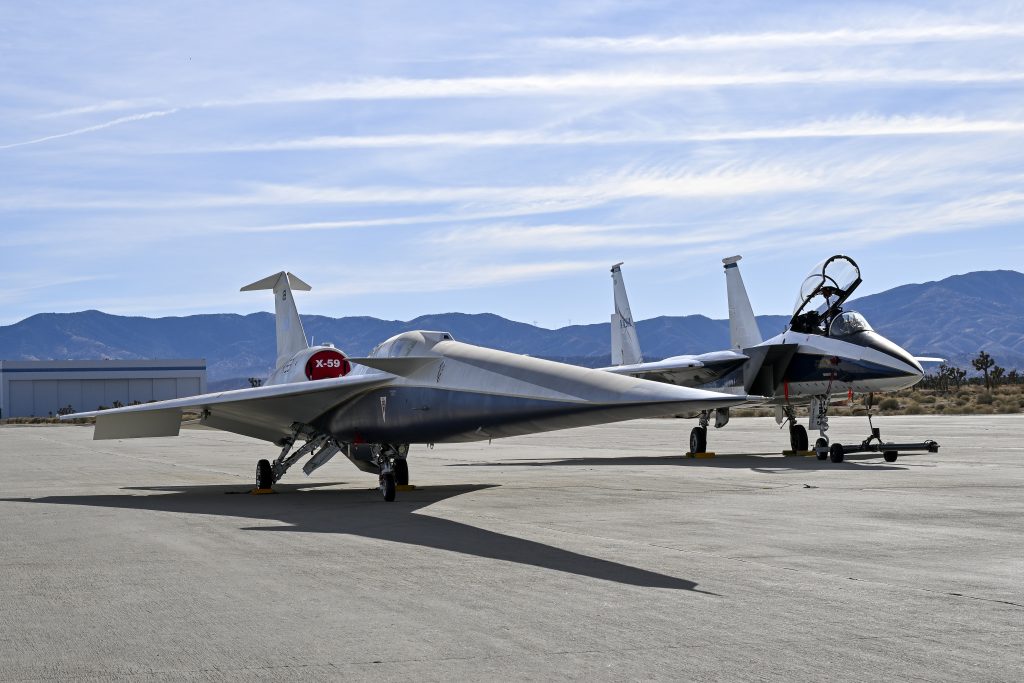NASA’s quiet supersonic X-59 research aircraft has cleared electromagnetic testing, confirming its systems will work together safely, without interference across a range of scenarios.
“Reaching this phase shows that the aircraft integration is advancing,” said Yohan Lin, NASA’s X-59 avionics lead. “It’s exciting to see the progress, knowing we’ve cleared a major hurdle that moves us closer to X-59’s first flight.”
Electromagnetic interference occurs when an electric or magnetic field source affects an aircraft’s operations, potentially impacting safety. This interference, whether from an external source or the aircraft’s own equipment, can disrupt the electronic signals that control critical systems – similar to effects that lead to static or crackling on a radio from a nearby emitting device, like a phone.
The tests, conducted at contractor Lockheed Martin Skunk Works’ facility in Palmdale, California, ensured that the X-59’s onboard systems – such as radios, navigation equipment, and sensors – did not interfere with one another or cause unexpected problems. During these tests, engineers activated each system on the aircraft one at a time while they monitored the other systems for possible interference.
“This testing helped us determine whether the systems within the X-59 are interfering with each other,” Lin said. “It’s called a source-victim test – essentially, we activate one system and monitor the other for issues like noise, glitches, faults, or errors.”
The X-59 will generate a quieter thump rather than a loud boom while flying faster than the speed of sound. The aircraft is the centerpiece of NASA’s Quesst mission, which will provide regulators with information that could help lift current bans on commercial supersonic flight over land. Currently, the aircraft is progressing through ground tests to ensure safety and performance. These included the recent, successful completion of a set of engine tests. The electromagnetic interference testing to examine the X-59’s internal electronic systems followed.
Other electromagnetic interference testing involved the team looking at the operation of the X-59’s landing gear, ensuring this critical component can extend and retract without affecting other systems. And they tested that the fuel switch shutoff was functioning properly without interference.
Electromagnetic compatibility was also assessed during this testing – making sure the X-59’s systems will function properly when it eventually flies near NASA research aircraft.
Researchers staged the X-59 on the ground in front of NASA’s F-15D, placing them 47 feet apart, then 500 feet apart. The proximity of the two aircraft replicated conditions needed for the F-15D to use a special probe to gather measurements about the shock waves the X-59 will produce.
“We want to confirm there’s compatibility between the two aircraft, even at close proximity,” Lin said.
For the electromagnetic compatibility testing, the team powered up the X-59’s engine while turning on the F-15D’s radar, C-band radar transponder, and radios. Data from the X-59 were transmitted to NASA’s Mobile Operations Facility, where control room staff and engineers monitored for anomalies.
“You want to make discoveries of any potential electromagnetic interference or electromagnetic compatibility issues on the ground first,” Lin said. “This reduces risk and ensures we’re not learning about problems in the air.”
Now that electromagnetic testing is complete, the X-59 is ready to move on to aluminum bird tests – during which data will be fed to the aircraft on the ground under both normal and failure conditions – and then taxi tests before flight.








